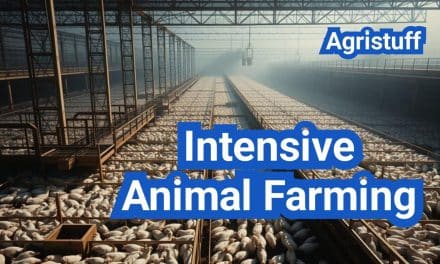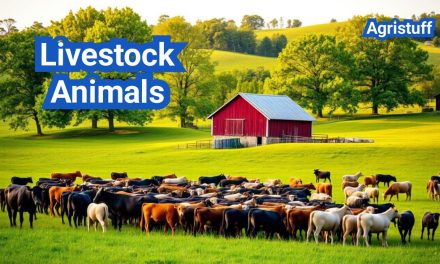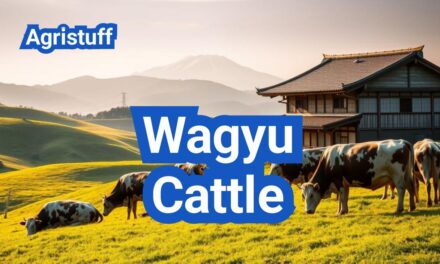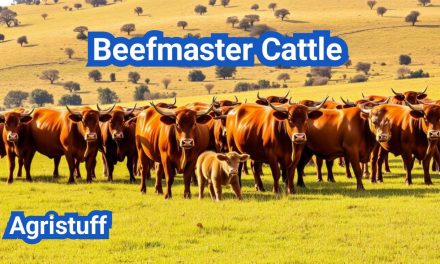The Spanish Goat breed has a rich history that dates back to the 16th century when it was first introduced to the Americas by Spanish explorers. These hardy animals were brought to the Caribbean Islands and later to what is now the United States and Mexico.
Known for their versatility and adaptability, Spanish Goats have become an integral part of the livestock landscape. They have been used for various purposes, including meat production and brush control. Their ability to thrive in different environments has made them a valuable asset for farmers and ranchers.
This article will delve into the history, origin, characteristics, breeding practices, and uses of Spanish Goats, providing a comprehensive overview for readers interested in this breed.
Key Takeaways
- Spanish Goats were introduced to the Americas in the 16th century.
- They are valued for their hardiness and versatility.
- Uses include meat production and brush control.
- The breed is adaptable to various environments.
- Spanish Goats have become integral to the livestock landscape.
The History and Origin of Spanish Goats
The Spanish goat breed has a rich history that spans centuries, originating from Spain and evolving significantly upon its introduction to the Americas. Their journey is closely tied to the early history of colonization in the New World.
Spanish goats were first introduced to the Americas in the 16th century by Spanish explorers and settlers. These early introductions were primarily for the purpose of providing a source of milk, meat, and hides. The goats were well-suited to the varied climates and terrains of the New World, demonstrating hardiness and adaptability.
Early Introduction to America
The early history of Spanish goats in America is marked by their rapid spread across the southern United States, particularly in areas that are now Texas, New Mexico, and Florida. They were often left to roam freely, allowing them to adapt to local conditions without intensive management.
This period of minimal human intervention allowed the breed to develop natural resistance to diseases and adapt to harsh environments. The lack of selective breeding during this time contributed to the development of a robust and versatile goat breed.
Development as a Landrace Breed
Over time, Spanish goats developed into a distinct landrace breed, shaped by natural selection and geographic isolation. A landrace breed is one that has developed largely through natural processes, with minimal artificial selection.
The development of Spanish goats as a landrace breed was influenced by several factors, including:
- Climate and geography of their surroundings
- Availability of food and water
- Natural predators and diseases
- Geographic isolation from other goat populations
These factors resulted in a breed that is well-suited to a variety of environments, making Spanish goats a valuable resource for farmers and ranchers across the Americas.
The Spanish Goat: A Comprehensive Breed Overview

The Spanish Goat breed is a unique and valuable resource for farmers and ranchers worldwide. Its history, characteristics, and adaptability make it an important breed for various agricultural practices.
Conservation Status and Importance
The Spanish Goat is considered a conservation priority due to its declining numbers and the threat of crossbreeding with other breeds. Efforts are being made to conserve the breed and promote its unique genetics. The conservation status of the Spanish goat is a concern among breeders and conservationists.
Conservation Efforts: Organizations dedicated to preserving the Spanish Goat breed are working to promote its use and conserve its genetic integrity.
| Conservation Status | Description | Importance |
|---|---|---|
| Endangered | The breed is at risk due to declining numbers. | High |
| Vulnerable | The breed is susceptible to crossbreeding. | Medium |
| Stable | The breed is being conserved and promoted. | Low |
Landrace Genetics and Their Value
The Spanish Goat’s landrace genetics are highly valued for their hardiness and adaptability. These traits make the breed an important resource for farmers and ranchers, particularly in challenging environmental conditions.
Hardiness and Adaptability: The breed’s ability to thrive in various environments is a significant advantage for agricultural practices.
Breed Associations and Registries
Breed associations and registries play a crucial role in promoting the Spanish Goat breed and conserving its genetic integrity. These organizations work to preserve the breed’s unique characteristics and promote its use among farmers and ranchers.
The work of breed associations and registries is essential for the long-term conservation of the Spanish Goat breed. By promoting the breed and its unique genetics, these organizations help ensure the breed’s continued viability.
Physical Characteristics of Spanish Goats
Spanish Goats are known for their robust physical characteristics, which have been shaped by their history and environment. These characteristics make them highly adaptable and valuable for various farming purposes.
Size and Weight Specifications
Spanish Goats vary significantly in size and weight, reflecting their diverse genetics and adaptability to different environments. Adults typically weigh between 50-200 lbs, with some individuals reaching even higher weights. This range in size and weight makes them suitable for different farming needs, from small-scale operations to larger commercial farms.
- Does typically weigh between 50-100 lbs.
- Bucks can weigh between 100-200 lbs or more.
- The breed’s size variability allows for flexibility in management and production.
Color Variations and Patterns
One of the notable features of Spanish Goats is their varied coloration. They can be found in a wide range of colors and patterns, including:
- Solid colors such as black, red, and white.
- Patterns like spotting, striping, and roaning.
- Combinations of colors, making each individual unique.
This diversity in coloration not only adds to their aesthetic appeal but also reflects their genetic diversity.
Distinctive Physical Features
Spanish Goats are also recognized by their distinctive physical features, which include:
- Horns, which are typically present in both males and females.
- Ears that are often carried erect or semi-erect.
- A robust build that indicates their hardiness and adaptability.
These features contribute to their overall appearance and are key identifiers of the breed.
In conclusion, the physical characteristics of Spanish Goats, including their size, weight, color variations, and distinctive features, make them a valuable and versatile breed for farming operations.
Behavioral Traits and Adaptability

Spanish Goats are distinguished by their remarkable ability to survive and thrive in challenging environments. Their behavioral traits and adaptability make them an attractive choice for farmers and land managers. The breed’s hardiness and foraging efficiency are key factors in their ability to flourish in diverse settings.
Natural Hardiness and Survival Skills
One of the defining characteristics of Spanish Goats is their natural hardiness. They possess a robust constitution that allows them to withstand harsh weather conditions and survive on limited resources. This hardiness is complemented by their survival skills, which have been honed through generations of adapting to challenging environments.
As noted by agricultural experts, “Spanish Goats are known for their ability to thrive in rugged terrain and under harsh climatic conditions, making them an ideal choice for land management and meat production.”
This breed’s resilience is a testament to its value in agricultural settings.
Foraging Behavior and Efficiency
Spanish Goats are skilled foragers, capable of surviving on a wide range of vegetation. Their foraging behavior is characterized by efficiency and adaptability, allowing them to make the most of available resources. This ability is crucial in maintaining their hardiness and overall health.
The efficiency of Spanish Goats as foragers is highlighted in the following table, which compares their foraging behavior with that of other breeds.
| Breed | Foraging Efficiency | Adaptability |
|---|---|---|
| Spanish Goat | High | Excellent |
| Boer Goat | Medium | Good |
| Kiko Goat | High | Very Good |
This comparison underscores the Spanish Goat’s superior adaptability and foraging efficiency, making it a valuable asset for farmers and land managers seeking to optimize their land use and livestock production.
Spanish Goat Uses and Economic Value
The versatility of Spanish goats makes them invaluable in different farming contexts, from meat production to land management. Their adaptability and hardiness contribute significantly to their economic importance.
Meat Production Qualities
Spanish goats are prized for their meat production qualities. Their meat is considered a delicacy in many cultures, and their ability to thrive in challenging environments makes them ideal for sustainable farming practices.
The characteristics that make Spanish goat meat desirable include its lean quality and the flavor profile, which is often enhanced by their diverse diet. Farmers appreciate the breed’s ability to produce high-quality meat with minimal input.
| Meat Quality Characteristics | Description | Benefit |
|---|---|---|
| Lean Quality | Lower fat content compared to other breeds | Appeals to health-conscious consumers |
| Flavor Profile | Diverse diet contributes to rich flavor | Enhances culinary versatility |
Brush Control and Land Management Benefits
Spanish goats are also utilized for brush control and land management. Their browsing behavior helps in managing vegetation, reducing the risk of wildfires, and maintaining open spaces.
Effective brush control is achieved through their feeding habits, which include consuming a wide variety of vegetation. This not only aids in land management but also promotes biodiversity.
Secondary Products and Services
In addition to meat production and brush control, Spanish goats provide secondary products such as hides and fiber. These products can be used to create a range of goods, from leather products to textiles.
The economic value of these secondary products adds to the overall profitability of raising Spanish goats. Farmers can diversify their income streams by selling these products, enhancing the sustainability of their operations.
- Hides: Used for leather production
- Fiber: Used for textile production
- Manure: Used as organic fertilizer
By leveraging these multiple uses, farmers can maximize the economic benefits of raising Spanish goats, contributing to the viability of their farming operations.
How to Start Raising Spanish Goats
For those looking to raise Spanish goats, the initial steps involve selecting the right foundation stock and setting up appropriate infrastructure. This guide will walk you through the essential considerations for starting a successful Spanish goat operation.
Selecting Quality Foundation Stock
Choosing the right foundation stock is crucial for the success of your Spanish goat operation. When selecting breeding animals, look for goats that exhibit strong physical characteristics typical of the breed, such as hardiness, agility, and resistance to diseases. It’s also important to consider the genetic diversity of your foundation stock to ensure the long-term health and viability of your herd.
When purchasing foundation stock, consider buying from reputable breeders who can provide health records and breeding information. The cost of foundation stock can vary based on factors like age, quality, and breeding potential. It’s advisable to invest in animals that have been well-cared for and are free from common health issues.
Initial Setup Requirements
Setting up your Spanish goat operation requires careful planning of the infrastructure. This includes fencing that is sturdy enough to contain the goats and protect them from predators. The fencing should be at least 5 feet tall and made of materials like woven wire or high-tensile wire.
Housing for Spanish goats should provide adequate shelter from the elements. Goats need protection from extreme weather conditions, so the housing should be well-ventilated and dry. You can use simple structures like barns or sheds, ensuring there is enough space for the goats to move around comfortably.
Current Market Trends and Price Ranges
Understanding the current market trends and price ranges for Spanish goats is essential for making informed decisions. The demand for Spanish goats can fluctuate based on factors like meat production needs and land management requirements. Currently, there is a growing interest in using Spanish goats for brush control, which can impact the market price.
The price of Spanish goats can vary widely depending on factors such as age, sex, and breeding quality. On average, you can expect to pay between $100 to $300 per head for commercial goats, while high-quality breeding stock can cost significantly more. Staying informed about market trends can help you make the most of your investment.
By carefully selecting quality foundation stock, setting up the right infrastructure, and staying informed about market trends, you can establish a thriving Spanish goat operation. Whether you’re raising goats for meat production, brush control, or other purposes, a well-planned approach is key to success.
Housing and Fencing Requirements

Proper housing and fencing are crucial for the well-being and safety of Spanish Goats. Adequate shelter and secure fencing not only protect the goats from predators and harsh weather conditions but also help in managing their movement and grazing patterns effectively.
Shelter Design and Construction
The shelter for Spanish Goats should be designed to provide protection from the elements. A well-ventilated, dry, and draft-free shelter is ideal. The structure should be sturdy enough to withstand various weather conditions. When constructing a shelter, consider using locally available materials to keep costs low. Ensure the shelter is spacious enough to accommodate the goats comfortably.
Key considerations for shelter design include:
- Orientation to maximize natural light and ventilation
- Roofing material that is durable and weather-resistant
- Fencing around the shelter to prevent escape and predator entry
Effective Fencing Strategies
Fencing is a critical aspect of Spanish Goat farming. The fencing should be strong enough to keep predators out and the goats in. A combination of fencing materials such as wood, metal, and high-tensile wire can be used. The height of the fence should be at least 5 feet to prevent jumping. Regular inspection and maintenance of the fencing are necessary to ensure its effectiveness.
Effective fencing strategies include:
- Using multiple strands of wire for added security
- Installing fencing that is difficult for goats to climb or jump over
- Regularly checking for damage or weaknesses in the fence
By implementing proper housing and fencing, farmers can significantly improve the health and productivity of their Spanish Goats. It’s a crucial investment in the overall success of the farming operation.
Feeding and Nutrition Management

Providing optimal nutrition for Spanish Goats involves understanding their dietary needs and implementing appropriate feeding strategies. As ruminants, Spanish Goats have specific nutritional requirements that must be met to ensure their overall health and productivity.
Basic Dietary Requirements
Spanish Goats require a diet that includes a mix of forage and concentrates. Forage, such as hay and pasture, should make up the bulk of their diet, providing essential fiber and nutrients. Concentrates, including grains and protein supplements, can be added to support their nutritional needs, particularly during periods of high production or when forage quality is poor.
The quality and quantity of forage available can significantly impact the nutritional status of Spanish Goats. High-quality forage can meet many of their nutritional needs, reducing the requirement for supplemental feeding. However, during certain times of the year or in areas with poor pasture quality, additional nutritional support may be necessary.
Supplemental Feeding Programs
Supplemental feeding programs are designed to support the nutritional needs of Spanish Goats, particularly during periods when their dietary requirements are not fully met by available forage. These programs can include the provision of grains, protein supplements, and vitamins to ensure that the goats receive a balanced diet.
The decision to implement a supplemental feeding program should be based on factors such as the age, size, and production level of the goats, as well as the quality and availability of forage. For example, does in late pregnancy or early lactation may require additional nutritional support to meet their increased energy and nutrient needs.
Water and Mineral Requirements
Adequate access to clean water is essential for the health and productivity of Spanish Goats. Water intake can vary depending on factors such as temperature, humidity, and the moisture content of their diet. Ensuring that goats have access to fresh, clean water at all times is crucial.
In addition to water, Spanish Goats require a range of minerals to support their overall health. Key minerals include calcium, phosphorus, and selenium, among others. Providing a mineral supplement or ensuring that their diet includes mineral-rich feeds can help meet these needs.
| Nutrient | Function | Sources |
|---|---|---|
| Protein | Supports growth and milk production | Grains, legumes, protein supplements |
| Calcium | Essential for bone health | Legumes, mineral supplements, alfalfa hay |
| Phosphorus | Important for bone health and energy production | Grains, protein supplements, mineral mixes |
By understanding and meeting the dietary needs of Spanish Goats, producers can help ensure the health, productivity, and profitability of their operations. Effective feeding and nutrition management strategies are critical components of successful Spanish Goat production.
Spanish Goat Breeding Programs and Practices

Spanish Goat breeding involves a comprehensive approach, including the selection of quality breeding stock and management of the breeding season. Effective breeding programs are crucial for maintaining the health, productivity, and genetic diversity of the herd.
Selection Criteria for Breeding Stock
Selecting the right breeding stock is fundamental to the success of a Spanish Goat breeding program. Key characteristics to look for include:
- Genetic diversity: Ensuring a diverse gene pool to enhance the overall health and resilience of the herd.
- Physical health: Choosing animals with good physical condition and absence of genetic disorders.
- Reproductive health: Evaluating the reproductive history and health of potential breeding stock.
- Productivity: Selecting animals based on their growth rate, milk production (if applicable), and other relevant productivity metrics.
Managing Breeding Season and Reproduction
Managing the breeding season effectively is critical for maximizing reproductive success. This involves:
- Planning the breeding season: Timing the breeding to coincide with optimal environmental conditions.
- Monitoring reproductive health: Regular veterinary checks to ensure the health of breeding animals.
- Nutritional management: Providing adequate nutrition to support reproductive health.
Kid Management and Raising
The care and management of kids are vital for the overall success of a Spanish Goat breeding program. Key considerations include:
- Colostrum intake: Ensuring kids receive adequate colostrum for immune system development.
- Nutrition: Providing appropriate nutrition for growth and development.
- Health monitoring: Regular monitoring for signs of illness or distress.
By focusing on these critical areas, Spanish Goat breeders can improve the efficiency and success of their breeding programs, ultimately enhancing the productivity and health of their herds.
Effective Crossbreeding Strategies

Effective crossbreeding strategies can improve the overall quality and resilience of Spanish Goat herds. Crossbreeding can be an effective way to enhance the productivity and hardiness of Spanish Goats by introducing desirable traits from other breeds.
Popular Crossbreeding Combinations
Farmers often cross Spanish Goats with breeds like Boer or Kiko to leverage their beneficial characteristics. For instance, crossing with Boer goats can improve meat production qualities, while Kiko goats are known for their parasite resistance.
| Crossbreeding Combination | Benefits |
|---|---|
| Spanish Goat x Boer | Improved meat production, enhanced growth rate |
| Spanish Goat x Kiko | Increased parasite resistance, hardiness |
Maximizing Hybrid Vigor Benefits
Hybrid vigor, or heterosis, is a key benefit of crossbreeding. It results in offspring that are more robust and productive than either parent. To maximize hybrid vigor, farmers should select breeds that complement the strengths and weaknesses of Spanish Goats.
Preserving Valuable Genetic Traits
While crossbreeding can introduce new traits, it’s crucial to preserve the valuable genetic characteristics of Spanish Goats, such as their adaptability and fertility. Careful selection of breeding stock is essential to maintaining these traits.
Key Considerations:
- Select breeds that complement Spanish Goat traits
- Monitor genetic diversity to avoid inbreeding
- Preserve desirable characteristics through selective breeding
Health Management for Spanish Goats

The health management of Spanish Goats is a multifaceted approach that includes leveraging their natural parasite resistance. Spanish Goats are known for their hardiness and ability to resist certain parasites, making them a valuable asset for farmers looking to reduce their reliance on chemical treatments.
Leveraging Natural Parasite Resistance
One of the key advantages of Spanish Goats is their natural resistance to parasites. This resistance is a result of their genetic makeup and adaptation to various environments. To leverage this trait, farmers should:
- Select breeding stock with proven parasite resistance
- Implement rotational grazing practices to reduce parasite loads
- Monitor goat health regularly to identify any potential issues early
Preventing Common Health Issues
While Spanish Goats are hardy, they are not immune to all health issues. Common problems include internal parasites, hoof issues, and diseases such as caseous lymphadenitis. Prevention strategies include:
- Regular vaccinations against prevalent diseases
- Proper hoof care, including regular trimming
- Maintaining a clean and dry living environment
Vaccination and Health Maintenance Schedule
A well-planned vaccination and health maintenance schedule is crucial for the overall health of Spanish Goats. This includes:
- Initial vaccinations for kids
- Booster shots as recommended by a veterinarian
- Regular health checks to monitor for signs of illness or stress
By combining these strategies, farmers can maintain the health and productivity of their Spanish Goat herds.
Comparing Spanish Goats to Other Meat Breeds

Spanish Goats have gained recognition for their hardiness and productivity, but how do they stack up against other meat breeds like Boer and Kiko goats? When considering a breed for your operation, understanding the strengths and weaknesses of each is crucial.
Spanish Goat vs. Boer Goat Comparison
The Spanish Goat and Boer Goat are both popular choices for meat production, but they have distinct characteristics. Boer Goats are known for their fast growth rate and high meat yield, making them a favorite among producers looking for quick returns. Spanish Goats, on the other hand, are renowned for their hardiness and adaptability to various environments.
While Boer Goats excel in terms of meat production, Spanish Goats offer superior parasite resistance and can thrive in challenging conditions with minimal input. The choice between these breeds depends on your specific needs and management practices.
Spanish Goat vs. Kiko Goat Comparison
Kiko Goats are another breed that is often compared to Spanish Goats due to their similar hardiness and parasite resistance. Kiko Goats are known for their rapid growth rate and high fertility, making them an attractive option for producers. Spanish Goats, however, have a more established genetic base and are widely recognized for their maternal traits.
Both breeds are well-suited for challenging environments, but Spanish Goats may have an edge in terms of their broader genetic diversity. The decision between these breeds should be based on your operation’s specific requirements and market demands.
Selecting the Right Breed for Your Operation
Choosing the right breed involves considering several factors, including climate, management practices, and market conditions. It’s essential to evaluate the strengths and weaknesses of each breed in the context of your operation.
- Consider the climate and environmental conditions of your operation.
- Evaluate the management practices you can implement, such as feeding and health management.
- Understand the market demands and the type of product you aim to produce.
By carefully assessing these factors and comparing the characteristics of different breeds, you can make an informed decision that best suits your operation’s needs.
Spanish Goats for Small-Scale Farming

The adaptability and resilience of Spanish goats make them an attractive choice for small farmers. These goats are well-suited for small-scale farming due to their hardiness, versatility, and relatively modest space and resource requirements.
Space and Resource Requirements
Spanish goats require adequate fencing to prevent escape and predation. The fencing should be at least 5 feet tall and made of durable materials such as woven wire or high-tensile wire. In terms of space, a general rule of thumb is to provide at least 1/4 acre per goat for browsing and exercise.
Resource Requirements for Spanish Goats
| Resource | Requirement |
|---|---|
| Fencing | At least 5 feet tall, durable materials |
| Space | At least 1/4 acre per goat |
| Shelter | Protection from extreme weather |
| Water | Adequate clean water supply |
Economic Viability for Small Farms
Spanish goats can contribute significantly to the economic viability of small farms through meat sales and other products. They are known for their rapid growth rate and high-quality meat, making them a valuable asset for farmers looking to diversify their income streams.
Economic Benefits of Spanish Goats
- Meat sales
- Breeding stock sales
- Land management through browsing
- Diversification of farm products
Integration with Diversified Farming
Spanish goats can be integrated into diversified farming operations to enhance overall farm productivity and sustainability. They can be used for brush control, helping to maintain open pastures and reduce fire hazards. Additionally, their manure can be used as fertilizer, further contributing to the farm’s ecological balance.
By incorporating Spanish goats into their operations, small-scale farmers can benefit from their hardiness, versatility, and economic potential, making them a valuable addition to diversified farming systems.
Pros and Cons of Spanish Goat Production
Understanding the pros and cons of Spanish Goat production is crucial for farmers considering this breed. Spanish Goat production offers a unique set of advantages and challenges that distinguish it from other goat breeds.
Key Advantages of the Breed
Spanish Goats are known for their hardiness and adaptability, making them an excellent choice for various farming conditions. Some of the key advantages include:
- Hardiness: Spanish Goats are robust and can thrive in challenging environments.
- Adaptability: They can adapt to different climates and management systems.
- Productivity: Spanish Goats are known for their meat production qualities.
The breed’s ability to flourish in diverse conditions makes it an attractive option for farmers looking to diversify their operations.
| Advantages | Description |
|---|---|
| Hardiness | Robust and capable of thriving in challenging environments |
| Adaptability | Can adapt to different climates and management systems |
| Productivity | Known for their meat production qualities |
Potential Challenges and Solutions
While Spanish Goat production offers several benefits, it also presents some challenges. These include the need for careful management and effective marketing strategies.
Some of the potential challenges and their solutions are:
- Management Challenges: Requires careful management to maintain breed characteristics.
- Marketing Strategies: Effective marketing is necessary to capitalize on the breed’s unique qualities.
By understanding these challenges and implementing appropriate solutions, farmers can successfully manage Spanish Goat production.
At The End of: Spanish Goat
The Spanish Goat is a unique and valuable breed that offers a range of benefits and opportunities for farmers and ranchers. With its rich history, distinct characteristics, and multiple uses, this breed has proven to be a significant resource.
A comprehensive summary of the Spanish Goat breed highlights its hardiness, adaptability, and economic viability. The breed’s ability to thrive in various environments and its potential for meat production, brush control, and land management make it an attractive option for diverse farming operations.
In conclusion, the Spanish Goat breed is a valuable asset for the agricultural industry. Its characteristics and uses make it an ideal choice for farmers and ranchers seeking to diversify their operations and capitalize on emerging market trends. As the demand for sustainable and efficient farming practices continues to grow, the Spanish Goat is well-positioned to play a significant role in meeting these needs.
By understanding the breed’s history, characteristics, and uses, farmers and ranchers can make informed decisions about incorporating Spanish Goats into their operations, ultimately contributing to a more sustainable and productive agricultural sector.
FAQ
What is the origin of the Spanish Goat breed?
The Spanish Goat breed originated in Spain and was introduced to the Americas by Spanish explorers in the 16th century.
What are the characteristics of Spanish Goats?
Spanish Goats are known for their hardiness, adaptability, and versatility. They come in a range of sizes and colors, and are prized for their meat, milk, and hides.
What are Spanish Goats used for?
Spanish Goats are used for meat production, brush control, and land management. They are also used for secondary products such as hides and fiber.
How do I start raising Spanish Goats?
To start raising Spanish Goats, you need to select quality foundation stock, set up adequate housing and fencing, and understand the current market trends and price ranges.
What are the housing and fencing requirements for Spanish Goats?
Spanish Goats require adequate shelter and secure fencing to protect them from predators and prevent escape. The shelter should be designed to provide protection from the elements.
What are the dietary requirements for Spanish Goats?
Spanish Goats require a balanced diet that includes a mix of forage and concentrates, as well as access to clean water and essential minerals.
How do I manage the breeding program for Spanish Goats?
To manage a breeding program for Spanish Goats, you need to select quality breeding stock, manage the breeding season and reproduction, and provide adequate care and nutrition to the kids.
What are the benefits of crossbreeding Spanish Goats?
Crossbreeding Spanish Goats can result in hybrid vigor, improved productivity, and increased hardiness. Popular crossbreeding combinations include using Boer or Kiko goats.
How do I manage the health of Spanish Goats?
To manage the health of Spanish Goats, you need to leverage their natural parasite resistance, prevent common health issues, and implement a vaccination and health maintenance schedule.
Are Spanish Goats suitable for small-scale farming?
Yes, Spanish Goats can be suitable for small-scale farming, as they require relatively low space and resource requirements. They can also be integrated with diversified farming practices.
What are the pros and cons of Spanish Goat production?
The pros of Spanish Goat production include their hardiness, adaptability, and productivity. The cons include potential challenges such as parasite resistance and marketing. Solutions to these challenges include careful management and marketing.
How do Spanish Goats compare to other meat breeds?
Spanish Goats are compared to other meat breeds such as Boer and Kiko goats. The comparison highlights their relative advantages and disadvantages, including hardiness, productivity, and market demand.
What is the conservation status of the Spanish Goat breed?
The Spanish Goat breed is considered a conservation priority due to its relatively small population and the risk of crossbreeding with other breeds.
Conclusion of: Spanish Goat Breed
Introduction to Spanish Goat
The Spanish Goat is one of the most important historic meat goat types in North America, prized by farmers and ranchers for its toughness, browsing ability, and capacity to thrive on rough land where other livestock struggle. For U.S. producers who want a low-input, multi-purpose animal, the Spanish Goat can provide meat, control brush, and fit easily into rotational grazing systems. By understanding the history, characteristics, breeding options, and practical uses of the Spanish Goat, you can decide whether this resilient landrace breed belongs in your long-term grazing plan and farm business model. Learn more about the Spanish Goat from The Livestock Conservancy
History and Origin of the Spanish Goat
The roots of the Spanish Goat go back to the 1500s, when Spanish explorers and settlers transported hardy, all-purpose goats from the Iberian Peninsula to the Caribbean, Mexico, Florida, and the American Southwest. Many of these goats were turned loose or escaped, forming feral populations that survived under harsh conditions with little human selection. Over centuries, natural selection favored the strongest and most adaptable animals, gradually shaping the Spanish Goat into a landrace breed that is defined more by performance and hardiness than by strict show-ring standards or uniform appearance. Read a detailed history of Spanish Goat development in North America
As the Spanish Goat spread across Texas and the southeastern United States, ranchers relied on these goats for meat, milk, hides, and especially for brush control in large cattle and sheep operations. Long before imported meat breeds arrived, the Spanish Goat was essentially “America’s meat goat,” producing kids on rough browse and weeds with minimal supplemental feed. Historical records and genetic evidence indicate that many modern Spanish Goat lines still trace back to these early Iberian imports, preserving rare genetic diversity that can be valuable for modern low-input and regenerative farming systems. See Oklahoma State University’s breed profile of the Spanish Goat
Distribution and Conservation Status of the Spanish Goat
Despite its long history, the Spanish Goat experienced a sharp decline when highly promoted meat breeds like the Boer were imported into the United States. Many ranchers crossbred their existing Spanish Goat herds with Boer and other breeds to boost growth and muscling, which diluted pure Spanish Goat genetics. Today, conservation groups recognize the Spanish Goat as a priority heritage breed, and registrations and structured breeding programs have helped stabilize numbers. By raising pure or high-percentage Spanish Goat herds, U.S. farmers can support biodiversity while also utilizing a practical, low-maintenance meat and brush-control animal. Check the current conservation status of the Spanish Goat
Breed Identity and “Brush Goat” Terminology
One challenge with the Spanish Goat is that the term “Spanish” is often used loosely at livestock auctions to describe any mixed-breed brush goat of unknown ancestry. True Spanish Goat animals are landrace goats with documented bloodlines and a recognizable type, while many so-called Spanish or “brush goats” are actually generic native or crossbred goats. For farmers who want to preserve Spanish Goat genetics, participate in registries, or market breeding stock, it is important to work with reputable breeders, understand line names, and avoid assuming that any rough-coated brush goat is automatically a Spanish Goat. Review meat goat breed descriptions, including Spanish Goat types (UC ANR PDF)
Physical Characteristics of the Spanish Goat
The Spanish Goat shows considerable variation in color and body type because it is a landrace rather than a tightly standardized pure breed. Spanish Goat coats may be solid black, red, white, or brown, or show combinations such as roan, spotted, or striped patterns. Horns are common in both sexes; Spanish Goat bucks usually have large, sweeping, often twisted horns, while does have lighter but still well-developed horns. Ears on the Spanish Goat are generally medium in size and held horizontally or slightly forward, and the overall body frame is moderate and athletic rather than extremely heavy or fine-boned. Explore physical traits of the Spanish Goat in OSU’s breed description
In terms of size, the Spanish Goat typically ranges from about 70–125 pounds for mature does and 150–250 pounds for mature bucks under U.S. production conditions, although body weight depends heavily on forage quality and management. The build of the Spanish Goat emphasizes durability, strong feet and legs, and efficient foraging ability more than extreme muscling. Many Spanish Goat lines grow a cashmere-like undercoat in cold climates, which helps them tolerate harsh winters, while their tough hooves and agile frame make the Spanish Goat well suited for rocky hillsides, brushy draws, and uneven terrain. See the American Spanish Goat Association’s breed standards
Temperament and Behavior of the Spanish Goat
The Spanish Goat is known for being active, alert, and independent, traits that helped the breed survive for generations in semi-feral conditions. When raised with minimal handling, Spanish Goat herds can be flighty and wary of humans, but kids that are handled early usually grow into manageable adults. The strong browsing instinct of the Spanish Goat leads it to seek out woody plants, briars, weeds, and vines that other livestock leave untouched. This behavior makes the Spanish Goat ideal for integrated grazing systems that combine brush control with meat production in many parts of the United States. Read ATTRA’s guide on meat goats and behavior, including Spanish Goat systems
Reproductive Traits and Mothering Ability
Reproductive performance is a major strength of the Spanish Goat. Spanish Goat does are generally fertile, cycle reliably, and exhibit strong mothering instincts, which are essential traits for pasture-based meat goat operations. Research comparing Boer, Kiko, and Spanish Goat does suggests that Spanish Goat and Kiko does often show better longevity and cumulative kid production under grazing conditions than Boer does, partly because hardy does remain healthy for more breeding seasons. In practical terms, this means your Spanish Goat herd can produce more kids over the lifetime of each doe, which supports profitability in low- and medium-input systems. See research comparing Spanish Goat does with Boer and Kiko does
Breeding and Selection Programs for Spanish Goat
Successful breeders focus on preserving the core strengths of the Spanish Goat: hardiness, parasite tolerance, good feet and udders, strong mothering ability, and efficient performance on forage. Organizations such as the American Spanish Goat Association and breeder networks like Spanish Goats LLC help maintain registries and document bloodlines so that producers can identify authentic Spanish Goat genetics. When selecting replacements for your Spanish Goat herd, emphasize traits like vigor at birth, growth on pasture, low parasite burden, and good temperament, so that each generation of Spanish Goat kids is better adapted to your specific environment and management style. Visit Spanish Goats LLC for Spanish Goat registry and bloodline information
Meat Production and Carcass Quality in Spanish Goat
As a meat animal, the Spanish Goat produces lean, flavorful carcasses that are especially popular in ethnic and niche markets across the United States. While Spanish Goat kids may not grow as rapidly or heavily as kids from highly selected Boer lines under feedlot conditions, they are very competitive under pasture-based and brush-based systems. Spanish Goat does routinely raise twins using mostly browse and pasture, and their kids can reach market weights efficiently when supported with sound forage management. For producers targeting natural, grass-based, or low-input markets, the Spanish Goat offers a good balance of growth and resilience. Review meat goat breed comparisons including Spanish Goat (OSU PDF)
Many commercial producers in the USA use the Spanish Goat as a maternal base in crossbreeding systems, pairing Spanish Goat does with Boer, Kiko, or other terminal sires to combine hardiness with improved carcass traits. In this model, the Spanish Goat doe contributes fertility, mothering ability, and parasite resilience, while the sire adds rapid growth and muscling. Well-designed crossbreeding programs built on a solid Spanish Goat base can increase kid performance and carcass weights, but producers must still cull aggressively for weak udders, poor feet, or chronic health problems to keep the Spanish Goat herd efficient over time. Learn how crossbreeding fits into meat goat production systems
Spanish Goat for Brush Control and Land Management
One of the most valuable uses of the Spanish Goat is targeted grazing for brush and weed control. Spanish Goat herds naturally seek out woody plants, invasive vines, and problem weeds such as multiflora rose, honeysuckle, and kudzu, converting low-value vegetation into saleable meat. On many cattle farms, adding a Spanish Goat enterprise improves pasture health by reducing brush encroachment and increasing plant diversity. Research and farmer experience show that Spanish Goat and Spanish-type goats are particularly effective in rough, overgrown areas where machinery and herbicides are difficult or costly to use for vegetation control. Read a SARE project on using goats, including Spanish Goat types, for weed control
Feeding and Nutrition of the Spanish Goat
The Spanish Goat is well adapted to forage-based diets and is famous for thriving on browse, brush, and mixed pastures with relatively low grain input. Nevertheless, good nutrition remains essential for Spanish Goat productivity, especially during late gestation, early lactation, and periods of drought or poor forage quality. Spanish Goat herds should always have access to clean water, high-quality mineral supplements (including appropriate copper levels), and enough energy and protein to maintain body condition. Rotational grazing, proper stocking rates, and attention to seasonal forage availability will help the Spanish Goat herd stay healthy and productive year-round. Find goat nutrition resources for Spanish Goat herds from NC State Extension
Health, Parasite Resistance, and Longevity
The Spanish Goat has a reputation for being relatively resilient to internal parasites and health problems compared with some intensive meat breeds, which is a major advantage in humid areas of the USA. Studies in the southeastern United States have found that Spanish Goat and Kiko does tend to have better stayability and lower health-related culling than Boer does under pasture-based management, leading to more kids raised over each doe’s lifetime. Even so, Spanish Goat producers must practice integrated parasite management—using FAMACHA scoring, strategic deworming, pasture rotation, and culling of susceptible animals—to maintain strong genetic resistance and long-term herd health. Review longevity and parasite-related performance in Spanish Goat research
Economics and Suitability for U.S. Farmers
From an economic perspective, the Spanish Goat fits best in low- to moderate-input systems where feed costs and labor must stay under control. Spanish Goat does can raise profitable kid crops on brushy or marginal land that might otherwise have little value, while also providing ecological services through brush control and increased plant diversity. For small and mid-size farmers, the choice between pure Spanish Goat herds and Spanish-based crossbreds depends on local markets, climate, and long-term goals, but in many regions the Spanish Goat offers a practical, hardy, and flexible foundation for meat and vegetation-management enterprises. Explore economic and marketing considerations for Spanish Goat meat
Getting Started with Spanish Goat in the USA
If you are considering adding the Spanish Goat to your operation, start by clarifying whether your main goals are meat production, brush control, conservation of genetics, or a combination of all three. For purebred or registered Spanish Goat stock, work with breeders listed through registries and associations, ask about bloodlines, and visit farms to see how Spanish Goat herds are managed in real-world conditions. New producers should also develop a basic health program, plan fencing and water systems for rotational grazing, and learn handling techniques suited to active, browsing goats so that the Spanish Goat can perform well from the start. Explore beginner guidance for raising Spanish Goat herds
Final thought
For many modern U.S. farms and ranches, the Spanish Goat represents a powerful blend of heritage genetics and practical performance. This landrace meat goat was shaped by centuries of natural selection to thrive on rough forage, raise vigorous kids, and help control brush with fewer inputs than more fragile breeds. Whether you manage a small homestead in the eastern woodlands, a mixed cattle-and-goat ranch in Texas, or a regenerative grazing project in the Appalachian foothills, thoughtfully integrating the Spanish Goat into your system can improve resilience, diversify income, and help preserve a unique piece of American livestock history. Learn how supporting Spanish Goat conservation benefits agriculture
Sources & References
- The Livestock Conservancy – Spanish Goat breed profile
- Oklahoma State University – Breeds of Livestock: Spanish Goats
- Spanish Goats LLC – History of Spanish Goats
- American Spanish Goat Association – Breed Standards
- University of California ANR – Breeds and Production Traits of Meat Goats (PDF)
- ATTRA – Meat Goats: Sustainable Production
- BMC Veterinary Research – Comparison of Boer, Kiko, and Spanish meat goat does
- SARE – Meat Goats for Weed Control and Alternative Income on Cattle Operations
- NC State Extension – Small Ruminants (Goat Resources)










